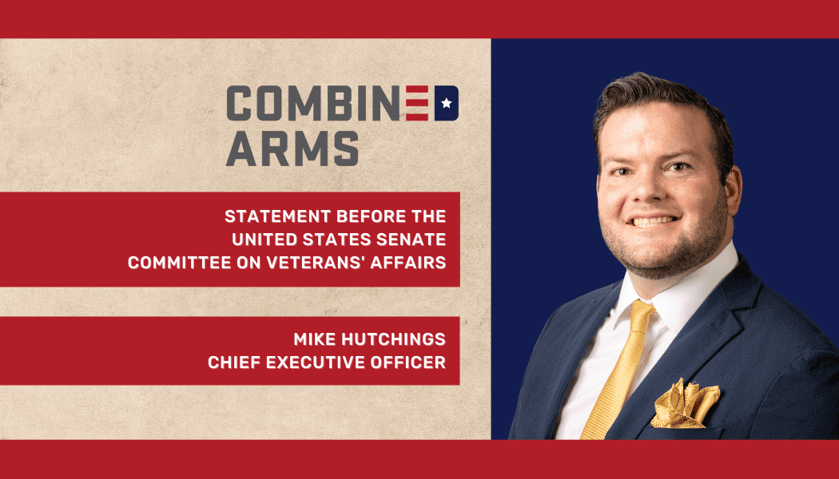STATEMENT OF COMBINED ARMS BEFORE THE
VETERANS’ AFFAIRS’ COMMITTEE
U.S. SENATE
MULTI-SECTORAL COLLABORATION: LEVERAGING PUBLIC AND PRIVATE PARTNERSHIPS TO IMPROVE SERVICE MEMBER AND VETERAN OUTCOMES
November 03, 2021
Chairman Tester, Ranking Member Moran, distinguished members of the Committee: Thank you for this opportunity to discuss how collaboration among the VA, DoD and through multi-sectoral partnerships can improve outcomes for Servicemembers and Veterans.
I am excited to report that in Texas and throughout the nation, community collaboration with the VA has never been stronger. It’s stronger because local VHA’s and VBA leadership understand the value that additional resources and organizations bring to our shared mission to improve the veteran transition experience, advance health outcomes for veterans, and, most importantly, prevent veteran suicide. Composed of other government agencies and local, regional, and national nonprofit organizations, Combined Arms’ 177 member agencies serve as effective force multipliers for VA & DoD programming and customer service. We’re able to fill gaps in programming through our network of trusted providers, we execute inter-agency referrals between government agencies and nonprofits, and we provide increased client enrollment in VA programs. While the DoD and VA can provide A-F with transition support services, it is organizations like Combined Arms that fulfill G-Z or serve those ineligible for VA services. Working in tandem enables a complete continuum of care, and Combined Arms stands ready to scale existing programs and partnerships to meet the ever evolving needs of our veteran and military families.
The Combined Arms Model
Combined Arms operates its innovative collaborative system through four major pillars:
- We’ve created an integrated technology platform that ensures veterans have access to thousands of social service resources provided by our vetted member organizations. We’ve flipped the accountability from the veteran to the service organizations by requiring all member organizations respond to veteran requests within 72 hours.
- We have deployed a white-labelled technology referral platform to veteran non-profit hubs and collaboratives across the nation. Currently, Combined Arms’ technology platform is live and powering veteran hub ecosystems in 26 states across the nation.
- We’ve also developed an inter-agency referral tool called Check-In. This application is available via Desktop or Mobile, and can refer a veteran to any organization in the collaborative in less than 30 seconds, or can refer a veteran directly to our licensed social work intake team, if a more hands-on approach is required for care.
- Our TX-based Transition Center serves as a co-working space that's available to all member agencies, creating intentional collaborative collisions for organizations that serve military veteran families.
Partnership, collaboration, and large scale convening of resources are the cornerstone of Combined Arms’ methodology and demonstrated success. I’d like to highlight a handful of our partnerships with federal entities that have yielded increased collaboration among organizations and, more importantly, better care for our nation’s veterans.
Collaboration with the VA
15 different VA programs and clinics at the Michael E. DeBakey VA Medical Center have been assigned to work within the Combined Arms system. This partnership allows the VA to utilize our system to refer veteran patients to nonprofit agencies delivering social services not provided by the DeBakey VA. Similarly, other agencies can refer veteran clients into the VBA and VHA programs. Additionally, we’ve joined forces with the VA in “VetConnect Days” to make VBA and VHA programs and care more accessible to veteran clients seeking services through the Combined Arms system. These events increase client enrollment into VA programs.
Department of Labor Collaboration
We work with the Department of Labor’s Veterans’ Employment and Training Services Employment Navigator and Partnership Pilot) to directly connect TSM’s and Spouses to quality employment and training resources.
Department of Defense
Since launching the Texas Veterans Network in April 2020, we have established a regular presence at all the major military installations in Texas. Each visit allows Combined Arms the opportunity to demonstrate the importance of community based resources as well as how to connect TSMs via our technology. To ensure that no service member falls through the cracks, Combined Arms should be included in transition workshops or transition checklists, which would encourage the TSM to create a Combined Arms profile prior to separation.
Conclusion
In summary, Combined Arms has developed, perfected, and scaled a proven downstream model to directly connect veterans and military families with organizations that serve them. In order to make continued progress towards our collective goal of successful veteran transitions, community-based organizations must be given a greater opportunity to work closer with federal agencies. By having federal, state, and community based organizations working in close collaboration, we can accelerate and streamline transitioning service member and veteran access to critically-needed resources which will help prevent unemployment and underemployment, substance abuse, family challenges, homelessness, and criminal behavior and, in turn, save veteran lives.
Thank you again for your consideration of this testimony and for your continued service to our military veteran community.
